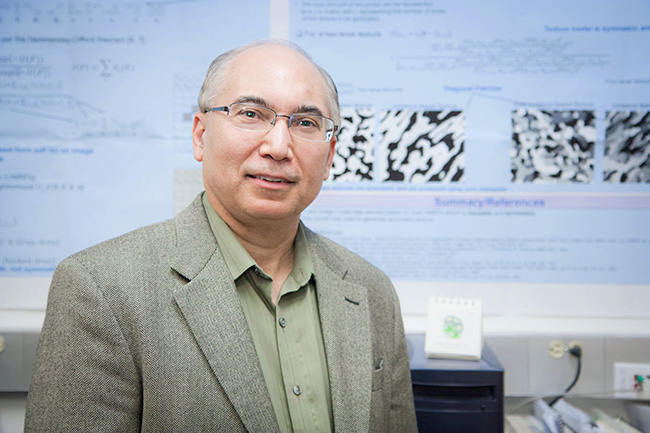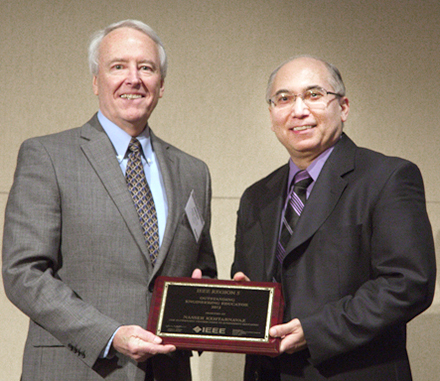
Colleagues praised Dr. Nasser Kehtarnavaz as an instructor whose work bridges the gap between the innovative and the practical.
Dr. Nasser Kehtarnavaz, professor of electrical engineering, often makes it on informal student lists of the most influential faculty members in the Erik Jonsson School of Engineering and Computer Science.
Siamak Yousefi, who earned a doctorate in electrical engineering last school year, said Kehtarnavaz provided continuous support and invaluable advice.
Vani Gopalakrishna, who graduated last May, said Dr. Kehtarnavaz was an inspiration. “He is very well organized, and always ready to discuss new things and teach, and more importantly he can understand a student’s point of view in many situations,” she said.
But it was his faculty colleagues and industry collaborators who nominated and endorsed him to receive the Outstanding Engineering Educator Award for Region 5 of the IEEE (Institute of Electrical and Electronics Engineers). The region includes more than 23,000 professional members from 12 states. He received the award earlier this month in Denver.
“Dr. Kehtarnavaz has pioneered and introduced innovative teaching materials that have bridged the gap between theoretical and practical aspects of signal processing education, thus allowing students to learn signal processing concepts more easily,” said Dr. Issa Panahi, associate professor of electrical engineering at UT Dallas and chair of the Dallas Chapter of IEEE Signal Processing Society, who nominated him. “These contributions go beyond a local or regional level and constitute a global impact on engineering education.”

James Jefferies, the IEEE's Region 5 director, presents Dr. Nasser Kehtarnavaz with the Outstanding Engineering Educator Award.
A licensed professional engineer, Kehtarnavaz’s close interactions with industry companies, such as Texas Instruments and National Instruments, have allowed him to gain insight into what kind of employees these companies seek to hire. Kehtarnavaz then instructs based on this firsthand knowledge.
“My motivation is to produce students who are in demand when they graduate,” he said. “Industry employers want students who know both theory and have experience implementing theory.
Kehtarnavaz, director of the Signal and Image Processing Lab, has co-authored eight books to help fill the need for practical aspects of signal processing education. These books are in use in at least a dozen other universities, and have allowed students to use modern programming tools for implementing signal processing algorithms.
One of his most popular books, An Interactive Approach to Signals and Systems Laboratory, was published for free on the educational site Connexions.
“I wanted to make the book accessible so that more students would benefit,” Kehtarnavaz said.
“My motivation is to produce students who are in demand when they graduate. Industry employers want students who know both theory and have experience implementing theory.”
Dr. Nasser Kehtarnavaz, professor of electrical engineering
His Real-Time Digital Signal Processing Based on the TMS320C6000, first published in 2000 and last revised in 2004 was the first laboratory book to give students hands-on implementation experience with the Texas Instruments C6000 digital signal processor family. These processors are used in many multimedia devices.
Kehtarnavaz has taught at UT Dallas since 2002. Before joining UT Dallas, he taught at Texas A&M University. He has graduated 22 doctoral and 32 master’s degree students.
“I encourage my students to put their classroom learning into practical use,” he said. “I’ve been an educator for 26 years. It is gratifying to receive this IEEE honor for contributions I have been able to make to engineering education.”